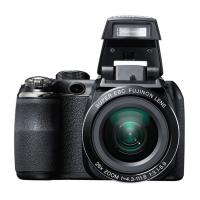
Do you have a question about the FujiFilm FINEPIX S4400 Series and is the answer not in the manual?
| Digital Zoom | 6.7x |
|---|---|
| LCD Screen Resolution | 230, 000 dots |
| Lens | Fujinon |
| Aperture Range | F3.1 - F5.9 |
| ISO Sensitivity | ISO 100 - 6400 |
| LCD Screen Size | 3.0-inch |
| Video Recording | 720p |
| Storage Media | SD / SDHC / SDXC |
| Battery | AA x 4 (alkaline or Ni-MH rechargeable) |
| Dimensions | 118 x 81 x 99 mm |
| Weight | 445 g (including battery and memory card) |
Covers the manual's symbols, conventions, and provides an overview of supplied accessories.
Details the different components and buttons of the camera with corresponding page references.
Explains the various indicators and icons displayed during shooting and playback modes.
Describes the function and usage of the electronic viewfinder for image composition.
Explains how to select different shooting modes by rotating the mode dial.
Instructions on how to attach the camera strap and lens cap securely.
Guide on how to correctly insert the camera's AA or rechargeable batteries.
Steps for inserting SD, SDHC, or SDXC memory cards into the camera.
Instructions for powering the camera on/off and switching between shooting and playback modes.
Initial camera setup including language selection and date/time configuration.
How to use the camera's automatic scene recognition mode for optimal shots.
Guidance on proper camera grip to prevent blur and ensure steady shots.
Instructions on how to view pictures on the camera's monitor and navigate through them.
Overview of available shooting modes and how to select them.
Capturing multiple shots at different zoom levels for varied perspectives.
Instructions for creating panoramic images by stitching multiple photos.
Using Program Auto Exposure mode for automatic exposure control.
Controlling shutter speed while the camera adjusts aperture for exposure.
Controlling aperture while the camera adjusts shutter speed for exposure.
Full manual control over both shutter speed and aperture for creative photography.
Saving and recalling custom camera and menu settings for quick access.
Automatically detects human faces for accurate focus and exposure.
Alerts the user if subjects may have blinked in the captured photo.
How to compose shots with off-center subjects by locking focus and exposure.
Techniques for capturing detailed close-up shots of small subjects.
Guidance on using the camera's intelligent flash system for optimal lighting.
Option to automatically process images to reduce red-eye effects.
How to use the self-timer for group photos or to avoid camera shake.
Capturing a sequence of pictures rapidly to record action or movement.
Using zoom to quickly frame erratically moving subjects in the display.
Adjusting exposure for scenes that are very bright, dark, or high-contrast.
Overview of viewing recent pictures and navigating through stored images.
How to zoom in and out on pictures during playback for detailed viewing.
Assigning star ratings to pictures for organization and search.
Displaying detailed shooting information and histograms for captured images.
Changing the number of images displayed simultaneously during playback.
How to play back and navigate through panoramic images.
Creating digital photo books from selected favorite pictures.
Searching for pictures based on date, face, scene, file type, or rating.
Methods for deleting individual pictures or all pictures from the memory card.
Instructions for shooting movies, including frame size, focus, and zoom.
How to play back recorded movies, control playback, and adjust volume.
Connecting the camera to a TV using USB-A/V or HDMI cable for group viewing.
Connecting the camera directly to a PictBridge-compatible printer for printing.
Creating and printing a DPOF order for compatible printers.
Steps to create a digital print order for PictBridge-compatible devices.
Installing software and connecting the camera to transfer and manage photos.
Navigating and adjusting settings within the shooting mode menus.
Details on ISO sensitivity and image size/aspect ratio settings.
Adjusting contrast and saturation for standard, vivid, or black and white images.
Comprehensive list of shooting settings and their available options.
Selecting image compression levels for fine or normal quality.
Adjusting color balance to match different light sources for natural colors.
Choosing sharpness levels for outlines: Hard, Standard, or Soft.
Selecting camera metering methods: Multi, Spot, or Average.
Configuring autofocus area selection: Center, Multi, Area, Continuous, or Tracking.
Registering and using face recognition for prioritized focus and exposure.
Setting the increment size for exposure bracketing in continuous shooting.
Adjusting flash brightness levels from +2/3 EV to -2/3 EV.
Navigating and adjusting settings within the playback mode menus.
Viewing pictures in an automated slide show with various transition options.
Overview of available options in the playback menu for managing photos.
Selecting images and movies to be queued for upload to YouTube or Facebook.
Option to process images and reduce red-eye effects caused by flash.
Protecting pictures from accidental deletion or formatting.
Creating a cropped copy of a picture to isolate a specific portion.
Creating smaller copies of pictures for easier sharing or storage.
Adjusting the orientation of pictures displayed in wide orientation.
Adding short voice memos to still pictures for contextual information.
Choosing how HD devices display pictures with different aspect ratios.
Accessing and adjusting camera settings like date, language, and system options.
Detailed list of all configurable settings available in the setup menu.
Switching the camera clock between home and local time zones for travel.
Formatting memory cards to prepare them for use or erase all data.
Setting how long pictures are displayed after shooting or enabling zoom.
Managing file numbering sequences and reset options for memory cards.
Adjusting volume levels for movie and voice memo playback.
Adjusting the brightness of the camera's LCD display.
Configuring the automatic power-off delay to conserve battery life.
Enabling or disabling digital zoom for additional magnification.
Process to discharge rechargeable Ni-MH batteries to improve capacity.
Option to add shooting date and time to pictures.
Overview of accessories compatible with the camera from FUJIFILM and other manufacturers.
Details on specific optional accessories offered by FUJIFILM, including AC adapters.
Recommendations for proper storage, use, cleaning, and travel with the camera.
Common problems related to power supply and battery issues and their solutions.
Troubleshooting issues related to menu language and display errors.
Solutions for problems encountered during the shooting process.
Troubleshooting issues related to the camera's autofocus system.
Resolving issues when face detection is not available or not working correctly.
Troubleshooting problems related to flash not firing or incorrect flash modes.
Solutions for issues encountered during picture playback and audio operations.
Troubleshooting problems related to TV, computer, or printer connections.
Addressing various other issues, including camera malfunctions and software installation.
Explains camera warnings and provides solutions for error messages.
Definitions of technical terms used throughout the manual.
Table showing approximate number of pictures and recording time based on memory card size.
Technical details of the camera, including sensor, lens, storage, and operating conditions.


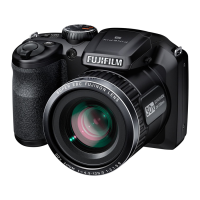
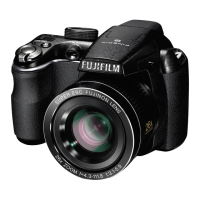



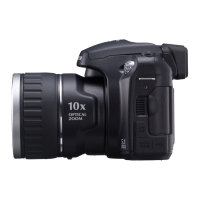
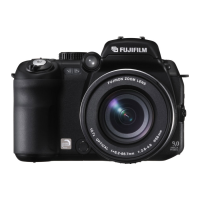
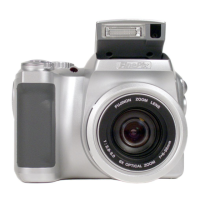
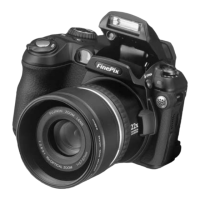
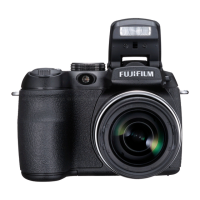
